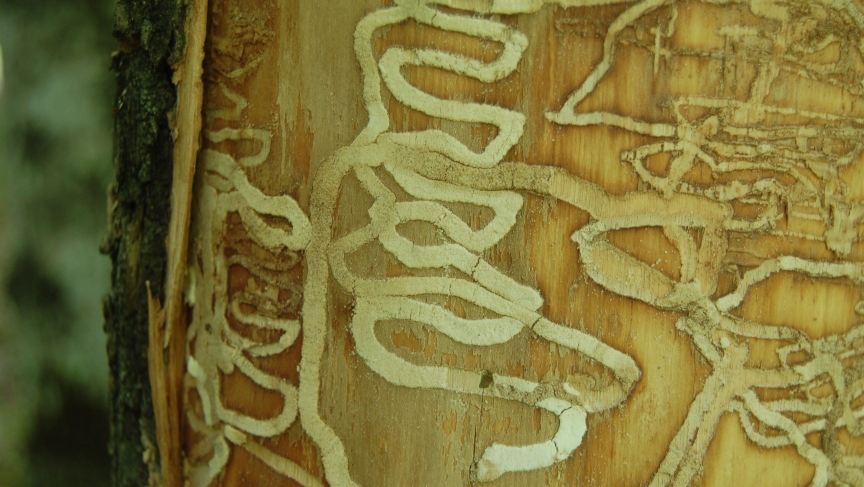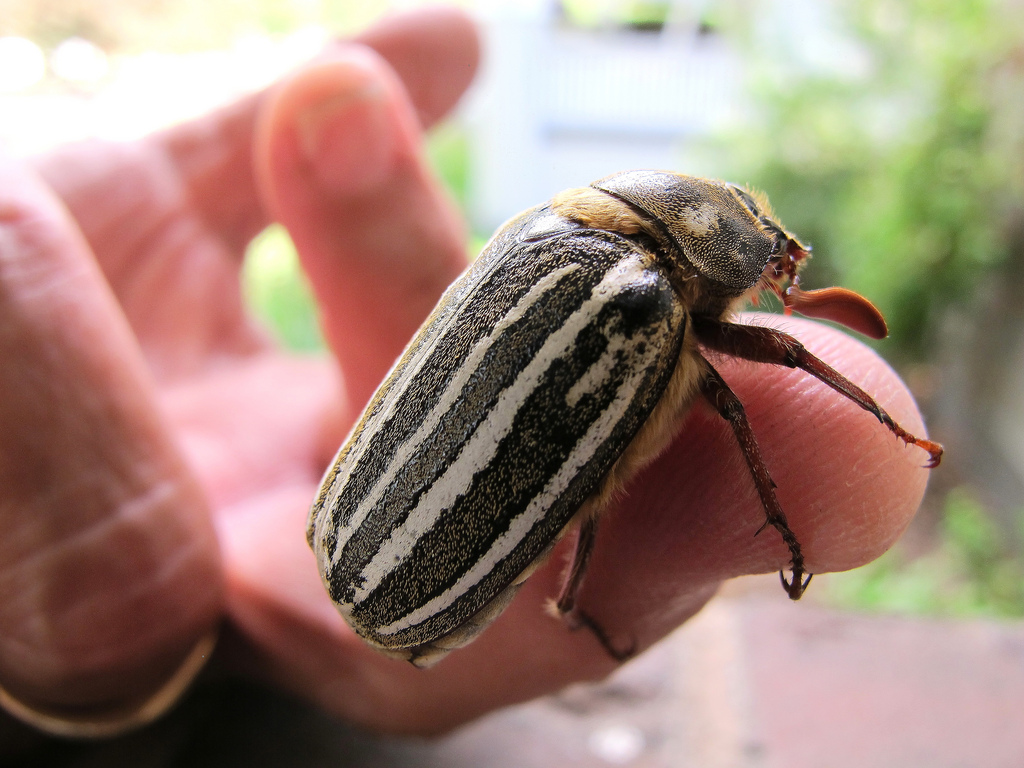Insects
Insects play a crucial role in the ecosystem as they serve as both pollinators and decomposers. However, their search for food can often lead to detrimental consequences for trees. For instance, certain species of insects, such as bark beetles, are attracted to weakened or stressed trees. These insects can detect the release of chemical signals emitted by trees in distress, indicating their vulnerability. Once they identify a tree that is already under attack, they can quickly join forces with their fellow insects to exploit its weakened state.
To illustrate this, let’s consider a scenario in a dense forest. A group of trees stands tall, each with its own unique characteristics and health status. Among them, there is a tree that has been weakened due to a prolonged drought, making it an easy target for opportunistic insects. As the insects approach the forest, they can sense the weakened tree’s distress signals and swiftly converge upon it. They burrow into the bark, creating tunnels and introducing harmful fungi and bacteria that further weaken the tree’s defenses.
However, the impact of insects on trees extends beyond just the individual tree they initially target. Insects can serve as vectors for diseases, carrying pathogens from one tree to another. For instance, the emerald ash borer, a notorious insect pest, spreads a deadly fungus called the “ash yellows” as it moves from tree to tree. This fungus attacks the tree’s vascular system, disrupting the flow of water and nutrients, ultimately leading to the tree’s demise.
Moreover, the constant threat from insects and diseases poses a significant challenge for arborists and tree caretakers. They must employ various strategies to maintain the health of trees and prevent infestations. Regular inspections, timely pruning, and the application of insecticides or biological controls are some of the measures taken to safeguard trees against these relentless attacks.
In conclusion, insects play a vital role in the natural world, but their search for food can have detrimental effects on trees. By targeting weakened or stressed trees, insects can quickly exploit their vulnerability and spread diseases to other trees. Therefore, it is crucial to prioritize the health of trees through proper care and management practices to minimize the impact of these relentless attacks.

Using a spray control for insects and diseases can be a cost-effective solution for homeowners with smaller-sized trees. These sprays can be easily found at local hardware stores like Ace Hardware, Menards, or Home Depot, making them accessible to anyone in need. By following the instructions provided, homeowners can apply the spray once spring begins, ensuring that their trees are protected from potential infestations or diseases.
It is crucial to apply the spray before or at the very early signs of insects or diseases. This proactive approach can prevent the problem from escalating and causing severe damage to the tree. By acting swiftly, homeowners can nip the issue in the bud and save their trees from potential harm.
However, if signs of insects or diseases start to occur or worsen despite using the spray, it is advisable to seek the expertise of a local arborist. Arborists are trained professionals who specialize in tree care and can provide valuable insights and recommendations. They can assess the situation, identify the specific pest or disease affecting the tree, and suggest appropriate treatments or interventions.
It is important to reiterate that using a spray control on diseases and pests is most effective when applied before any signs are visible or at the very early stages. This preventive approach can significantly reduce the chances of infestation or disease progression. However, if the spray does not seem to be working as expected, it is crucial to contact an arborist promptly. Delaying professional intervention can lead to worsening symptoms and a decreased likelihood of saving the tree.
The health of the tree plays a significant role in its ability to recover from pests or diseases. As the tree’s health deteriorates, its chances of survival diminish. Therefore, it is essential to address any signs of decline or dieback promptly. If homeowners start to notice these symptoms, such as wilting leaves, dead branches, or stunted growth, it is crucial to call for a consultation or treatment before it’s too late. Seeking professional help at this stage can potentially save the tree and restore its health.
In conclusion, using a spray control for insects and diseases can be an effective and cost-efficient solution for homeowners with smaller-sized trees. By applying the spray before or at the early signs of pests or diseases, homeowners can prevent further damage and protect their trees. However, if the spray does not yield the desired results, it is essential to consult a local arborist for expert advice. Remember, the sooner the intervention, the better the chances of saving the tree. So, stay vigilant, monitor your trees closely, and take prompt action to ensure their well-being.
Insects and diseases are the greatest factors of damage, low vigor, stress, and death in trees. In order to maintain your trees health, it’s important to know about some of the most common diseases and insect pests and how to control or avoid them.

pine false webworm
Acantholyda erythrocephala
Adult(s)
Barry Lyons
pine false webworm
Acantholyda erythrocephala
Larva(e)
Barry Lyons
pine false webworm
Acantholyda erythrocephala
Egg(s)
Barry Lyons
pine false webworm
Acantholyda erythrocephala
Damage
Steven Katovich
evergreen bagworm
Thyridopteryx ephemeraeformis
Adult(s)
Pennsylvania Department of Conservation and Natural Resources – Forestry
evergreen bagworm
Thyridopteryx ephemeraeformis
Egg(s)
Lacy L. Hyche
evergreen bagworm
Thyridopteryx ephemeraeformis
Damage
Terry S. Price
locust leafminer
Odontota dorsalis
Adult(s)
David Cappaert
locust leafminer
Odontota dorsalis
Larva(e)
Bruce W. Kauffman
locust leafminer
Odontota dorsalis
Damage
Ronald S. Kelley
elm leaf beetle
Xanthogaleruca luteola
Adult(s)
Joseph Berger
elm leaf beetle
Xanthogaleruca luteola
Larva(e)
Clemson University – USDA Cooperative Extension Slide Series
elm leaf beetle
Xanthogaleruca luteola
Damage
John A. Weidhass
Japanese beetle
Popillia japonica
Adult(s)
David Cappaert
Japanese beetle
Popillia japonica
Larva(e)
David Cappaert
Japanese beetle
Popillia japonica
Damage
Steven Katovich
common sawflies
Nematus spp.
Adult(s)
Lacy L. Hyche
common sawflies
Nematus spp.
Larva(e)
Lacy L. Hyche
common sawflies
Nematus spp.
Cocoon(s)
Lacy L. Hyche
gypsy moth
Lymantria dispar
Adult(s)
Pennsylvania Department of Conservation and Natural Resources – Forestry
gypsy moth
Lymantria dispar
Larva(e)
Ferenc Lakatos
gypsy moth
Lymantria dispar
Damage
Louis-Michel Nageleisen

tenlined June beetle
Polyphylla decemlineata
Larva(e)
Whitney Cranshaw

emerald ash borer
Agrilus planipennis
Adult(s)
David Cappaert
emerald ash borer
Agrilus planipennis
Larva(e)
David Cappaert
emerald ash borer
Agrilus planipennis
Damage
Daniel Herms
ash borer
Podosesia syringae
Adult(s)
Whitney Cranshaw
ash borer
Podosesia syringae
Larva(e)
James Solomon
ash borer
Podosesia syringae
Damage
James Solomon
bronze birch borer
Agrilus anxius
Adult(s)
Whitney Cranshaw
bronze birch borer
Agrilus anxius
Larva(e)
David G. Nielsen
bronze birch borer
Agrilus anxius
Galleries
Whitney Cranshaw
poplar borer
Saperda calcarata
Adult(s)
Whitney Cranshaw

poplar borer
Saperda calcarata
Damage
Minnesota Department of Natural Resources
cottonwood borer
Plectrodera scalator
Adult(s)
Donald Duerr
cottonwood borer
Plectrodera scalator
Larva(e)
James Solomon
cottonwood borer
Plectrodera scalator
Damage
University of Georgia
white oak borer
Goes tigrinus
Adult(s)
James Solomon
white oak borer
Goes tigrinus
Egg(s)
James Solomon
white oak borer
Goes tigrinus
Damage
James Solomon
flatheaded appletree borer
Chrysobothris femorata
Adult(s)
James Solomon
flatheaded appletree borer
Chrysobothris femorata
Larva(e)
James Solomon
flatheaded appletree borer
Chrysobothris femorata
Damage
James Solomon
red oak borer
Enaphalodes rufulus
Adult(s)
Gerald J. Lenhard
red oak borer
Enaphalodes rufulus
Larva(e)
James B. Hanson
red oak borer
Enaphalodes rufulus
Damage
Gerald J. Lenhard
Asian longhorned beetle
Anoplophora glabripennis
Adult(s)
Melody Keena
Asian longhorned beetle
Anoplophora glabripennis
Larva(e)
Michael Bohne
Asian longhorned beetle
Anoplophora glabripennis
Damage
Dennis Haugen
carpenter ants
Camponotus spp.
Adult(s)
Whitney Cranshaw
carpenter ants
Camponotus spp.
Larva(e)
Whitney Cranshaw
carpenter ants
Camponotus spp.
Damage
R. Werner
Call Or Text For a Free Quote
17330 W Center Rd. Omaha, NE. 68130. (No Storefront)
West Omaha, Omaha, Nebraska. 68130.
Service Area / Locations Serving:
West Omaha, Omaha, NE. Elkhorn, NE. Gretna, NE. Chalco, NE. Millard, NE. Springfield, NE. Louisville, NE. Papillion, NE. La vista, NE. Ralston, NE. Bellevue, NE. Bennington, NE. Plattsmouth NE.